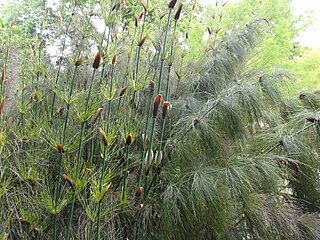
The Restionaceae, also called restiads and restios, are a family of flowering plants native to the Southern Hemisphere; they vary from a few centimeters to 3 meters in height. Following the APG IV (2016): the family now includes the former families Anarthriaceae, Centrolepidaceae and Lyginiaceae, and as such includes 51 genera with 572 known species. Based on evidence from fossil pollen, the Restionaceae likely originated more than 65 million years ago during the Late Cretaceous period, when the southern continents were still part of Gondwana.
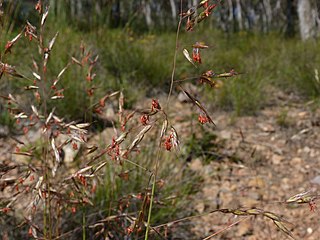
Rytidosperma pallidum, commonly known as red-anther wallaby grass, is an Australian species of tussock grass found in Victoria, New South Wales and the Australian Capital Territory. The grass has flowers in December, and the flowers have a prominent red anther, after which it is commonly named.

Triodia is a large genus of hummock grass endemic to Australia. The species of this genus are known by the common name spinifex, although they are not a part of the coastal genus Spinifex. Many soft-leaved Triodia species were formerly included in the genus Plectrachne. Triodia is known as tjanpi (grass) in central Australia, and have several traditional uses amongst the Aboriginal Australian peoples of the region.
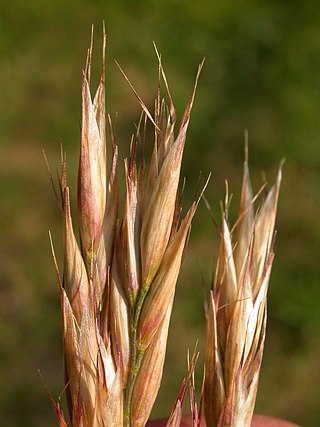
Danthonia is a genus of Eurasian, North African, and American plants in the grass family. Members of this genus are sometimes referred to as oatgrass, but that common name is not restricted to this genus. Other common names include heathgrass and wallaby grass. Australian species have since been reclassified into the genus Rytidosperma.

Bothriochloa is a common and widespread genus of plants in the grass family native to many countries on all inhabited continents and many islands. They are often called beardgrass, bluegrass or bluestem. Some species are invasive in areas where they have been introduced.

Eleocharis is a virtually cosmopolitan genus of 250 or more species of flowering plants in the sedge family, Cyperaceae. The name is derived from the Greek words ἕλειος (heleios), meaning "marsh dweller," and χάρις (charis), meaning "grace." Members of the genus are known commonly as spikerushes or spikesedges. The genus has a geographically cosmopolitan distribution, with centers of diversity in the Amazon Rainforest and adjacent eastern slopes of the South American Andes, northern Australia, eastern North America, California, Southern Africa, and subtropical Asia. The vast majority of Eleocharis species grow in aquatic or mesic habitats from sea level to higher than 5,000 meters in elevation.

Uncinia is a genus of flowering plants in the family Cyperaceae, known as hook-sedges in Australia and as hook grasses or bastard grasses in New Zealand. The genus is characterised by the presence of a long hook formed by an extension of the rachilla, which is used to attach the fruit to passing animals (epizoochory), especially birds, and it is this feature which gives the genus its name, from the Latin uncinus, meaning a hook or barb.
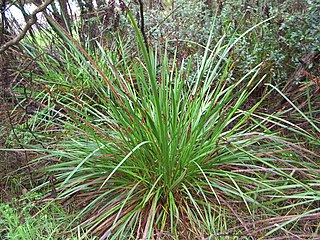
Lepidosperma is a genus of flowering plant of the family Cyperaceae. Most of the species are endemic to Australia, with others native to southern China, southeast Asia, New Guinea, New Caledonia and New Zealand.

Parsonsia is a genus of woody vines in the family Apocynaceae. Species occur throughout Indomalaya, Australasia and Melanesia.

Gahnia is a genus of sedges native to China, Southeast Asia, New Guinea, Australia, New Zealand and a number of Pacific Islands. The common name is due to the toothed margins. It often forms tussocks.
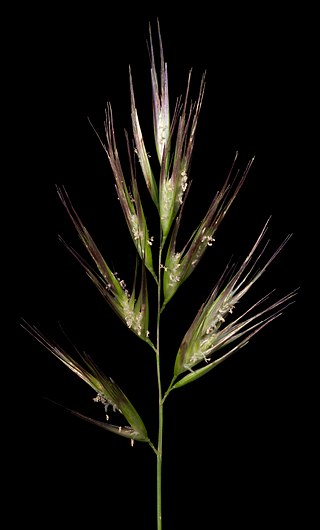
Rytidosperma caespitosum, known by various common names including common wallaby-grass, ringed wallaby-grass, and white-top, is a species of grass native to southern parts of Australia.

Dichelachne is a genus of Australian, Indonesian, and Pacific Island plants in the grass family. They are known commonly as plumegrasses.

Iseilema, commonly known in Australia as Flinders grass, is a genus of Asian and Australian plants in the grass family.

Neurachne, commonly called mulga grass, is a genus of Australian plants in the grass family.

Rytidosperma is a genus of plants in the grass family. Most of the species occur in Australasia, with a few in insular Southeast Asia, southern South America, and certain islands of the Pacific. Several are known by the general common name wallaby grass.
Rytidosperma unarede is a species of grass in the family Poaceae. The specific epithet is the Māori name unarede recorded by Raoul when the plant was first described in 1844.
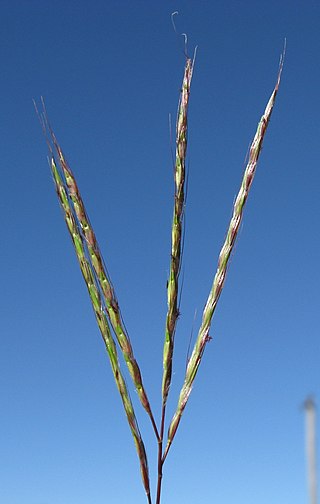
Bothriochloa macra, commonly known as red-leg grass, red grass, redleg or pitted beard grass is a perennial grass species that is native to eastern Australia and New Zealand. It is naturalised in Tasmania and Norfolk Island.

Rytidosperma tenuius, or purplish wallaby grass, is an Australian species of wallaby grass found in south eastern Australia, usually on clay or sandy soils in the drier eucalyptus woodlands. The grass is perennial, and it may grow up to 1.2 m tall. It is native to the Australian states of Queensland, New South Wales, Victoria, South Australia and Tasmania, and it has been introduced to New Zealand. The inflorescences have a characteristic reddish colouration, and the attractive purplish bracts of young flowers can also aid in identification. The specific epithet tenuius is derived from the Latin for thin.
Frederick Arthur Rodway was an Australian physician, botanist, and plant collector. He collected spermatophytes in New South Wales and Western Australia.
















